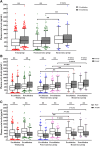Association of Preablation Plasma Corin Levels With Atrial Fibrillation Recurrence After Catheter Ablation: A Prospective Observational Study
- PMID: 38214265
- PMCID: PMC10926783
- DOI: 10.1161/JAHA.123.031928
Association of Preablation Plasma Corin Levels With Atrial Fibrillation Recurrence After Catheter Ablation: A Prospective Observational Study
Abstract
Background: We assessed the impact of pre- and postprocedural plasma corin levels on the recurrence of atrial fibrillation (AF) after catheter ablation (CA).
Methods and results: This prospective, single-center, observational study included patients undergoing their first CA of AF. Corin was measured before and 1 day after CA. The primary end point was recurrent AF between 3 and 12 months after ablation. From April 2019 through May 2021, we analyzed 616 patients with AF (59.09% men) with a mean age of 62.86±9.42 years. Overall, 153 patients (24.84%) experienced recurrent AF. In the recurrence group, the pre- and postprocedure corin concentrations were 539.14 (329.24-702.08) and 607.37 (364.50-753.80) pg/mL, respectively, which were significantly higher than the nonrecurrence group's respective concentrations of 369.05 (186.36-489.28) and 489.12 (315.66-629.05) pg/mL (both P<0.0001). A multivariate Cox regression analysis with confounders found that elevated preablation corin levels were significantly associated with an increased risk of AF recurrence after CA. Receiver operating characteristic curve analysis identified that a preablation corin threshold of >494.85 pg/mL predicted AF recurrence at 1 year. An increase of 1 SD in corin concentrations before CA (264.94 pg/mL) increased the risk of recurrent AF by 54.3% after adjusting for confounding variables (hazard ratio, 1.465 [95% CI, 1.282-1.655]; P<0.0001).
Conclusions: Plasma corin levels at baseline is a valuable predictor of AF recurrence after CA, independent of established conventional risk factors. Risk stratification before ablation for AF may be useful in selecting treatment regimens for patients.
Keywords: atrial fibrillation; catheter ablation; corin; natriuretic peptides; recurrence.
Figures







Similar articles
-
Impact of Midregional N-Terminal Pro-Atrial Natriuretic Peptide and Soluble Suppression of Tumorigenicity 2 Levels on Heart Rhythm in Patients Treated With Catheter Ablation for Atrial Fibrillation: The Biorhythm Study.J Am Heart Assoc. 2021 Jul 6;10(13):e020917. doi: 10.1161/JAHA.121.020917. Epub 2021 Jun 30. J Am Heart Assoc. 2021. PMID: 34187182 Free PMC article.
-
Pre-procedural TMAO as a predictor for recurrence of atrial fibrillation after catheter ablation.BMC Cardiovasc Disord. 2024 Dec 28;24(1):750. doi: 10.1186/s12872-024-04170-w. BMC Cardiovasc Disord. 2024. PMID: 39732662 Free PMC article.
-
The preablation monocyte/ high density lipoprotein ratio predicts the late recurrence of paroxysmal atrial fibrillation after radiofrequency ablation.BMC Cardiovasc Disord. 2020 Sep 7;20(1):401. doi: 10.1186/s12872-020-01670-3. BMC Cardiovasc Disord. 2020. PMID: 32894051 Free PMC article.
-
The effect of weight loss on recurrence of atrial fibrillation after catheter ablation: A systematic review and meta-analysis.J Cardiovasc Electrophysiol. 2023 Dec;34(12):2514-2526. doi: 10.1111/jce.16090. Epub 2023 Oct 3. J Cardiovasc Electrophysiol. 2023. PMID: 37787013
-
Circulating Galectin-3 and Atrial Fibrillation Recurrence after Catheter Ablation: A Meta-Analysis.Cardiovasc Ther. 2019 Apr 2;2019:4148129. doi: 10.1155/2019/4148129. eCollection 2019. Cardiovasc Ther. 2019. PMID: 31772609 Free PMC article.
Cited by
-
Positively charged cytoplasmic residues in corin prevent signal peptidase cleavage and endoplasmic reticulum retention.Commun Biol. 2025 Jan 20;8(1):89. doi: 10.1038/s42003-025-07545-7. Commun Biol. 2025. PMID: 39833422 Free PMC article.
-
Clinical Utility of the 4S-AF Scheme in Predicting Atrial Fibrillation Recurrence after Radiofrequency Catheter Ablation.Rev Cardiovasc Med. 2025 Mar 14;26(3):26318. doi: 10.31083/RCM26318. eCollection 2025 Mar. Rev Cardiovasc Med. 2025. PMID: 40160573 Free PMC article.
References
-
- Mont L, Bisbal F, Hernández‐Madrid A, Pérez‐Castellano N, Viñolas X, Arenal A, Arribas F, Fernández‐Lozano I, Bodegas A, Cobos A, et al. Catheter ablation vs. antiarrhythmic drug treatment of persistent atrial fibrillation: a multicentre, randomized, controlled trial (SARA study). Eur Heart J. 2014;35:501–507. doi: 10.1093/eurheartj/eht457 - DOI - PMC - PubMed
-
- Chen H, Li C, Han B, Xiao F, Yi F, Wei Y, Jiang C, Zou C, Shi L, Ma W, et al. Circumferential pulmonary vein isolation with vs without additional low‐voltage‐area ablation in older patients with paroxysmal atrial fibrillation: a randomized clinical trial. JAMA Cardiol. 2023;8:765–772. doi: 10.1001/jamacardio.2023.1749 - DOI - PMC - PubMed
Publication types
MeSH terms
LinkOut - more resources
Full Text Sources
Medical
Miscellaneous

